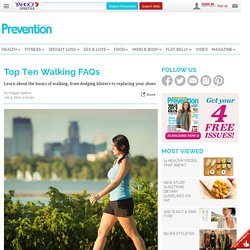

How to Go From Sedentary to Running in Five Steps. As a runner, there is almost nothing in this world that can take me to the places that running does.

I find solitude in my running, I find my thoughts and my peace, I find energy and motivation, I come up with my best ideas and solve my toughest problems. Running transforms me. I try to encourage others to run, but even if they want to do it, they don’t know how. Today, I’m going to give you my advice (as an intermediate runner, not an expert) on how to go from sitting on the couch to being a true runner.
I won’t say that it’ll be easy, especially in the beginning. I will start with the standard disclaimer: Before starting this program, get checked out by a doctor, especially if you have any health risks, such as heart or lung problems, major diseases, pregnancy, or the like. If you’re fit enough to walk for 20 or 30 minutes, you should be able to do this program. The Benefits of Running Why should you even consider doing this program (or running at all)?
You’ll get healthier. The Rules. [Collegiate Exercise] Dorm Room Fitness. Learn How To Properly Lace and Tie Your Running Shoes. Creating forward momentum - YouTube. Capítulo 9: Macronutrientes: carbohidratos, grasas y proteínas. Capítulo 9 La fuente principal de energía para casi todos los asiáticos, africanos y latinoamericanos son los carbohidratos.

Los carbohidratos constituyen en general la mayor porción de su dieta, tanto como el 80 por ciento en algunos casos. Por el contrario, los carbohidratos representan únicamente del 45 al 50 por ciento de la dieta en muchas personas en países industrializados. Los carbohidratos son compuestos que contienen carbono, hidrógeno y oxígeno en las proporciones 6:12:6.
Durante el metabolismo se queman para producir energía, y liberan dióxido de carbono (CO2) y agua (H2O). Monosacáridos, ejemplo, glucosa, fructosa, galactosa; disacáridos, ejemplo, sacarosa (azúcar de mesa), lactosa, maltosa; polisacáridos, ejemplo, almidón, glicógeno (almidón animal), celulosa. Monosacáridos Los carbohidratos más sencillos son los monosacáridos o azúcares simples. La fructosa se encuentra en la miel de abeja y algunos jugos de frutas. Disacáridos Polisacáridos Las proteínas son necesarias: Top Ten Walking FAQs - New Idea Magazine - Yahoo!7 Lifestyle. Learn about the basics of walking, from dodging blisters to replacing your shoes.

Q: What's the best time of day to walk? A: Any time of day is perfect; it varies from one person to the next. In summer, it's nice to walk in the mornings, when it's cooler. In winter, lunch hours work well; it's the warmest part of the day, the fresh air revitalises you for the afternoon and you get a healthy dose of vitamin D from the sun.
The real question is: when are you most willing and able to walk? Q: Should I eat before I walk? That said, a leisurely stroll after a large meal can assist digestion and burn a few extra kilojoules. Q: What's the simplest way to determine how fast I'm walking? 70 steps per minute equals about 20 minutes per kilometre, or 3 km/h.105 steps per minute equals about 12 minutes per kilometre, or 5 km/h.140 steps per minute equals about 10 minutes per kilometre, or 6 km/h. Q: How many kilojoules do I burn by walking 1 km? Q: When should I buy new shoes? Q: Help! Free Visual Workouts - StumbleUpon. Killer Kardio - StumbleUpon.